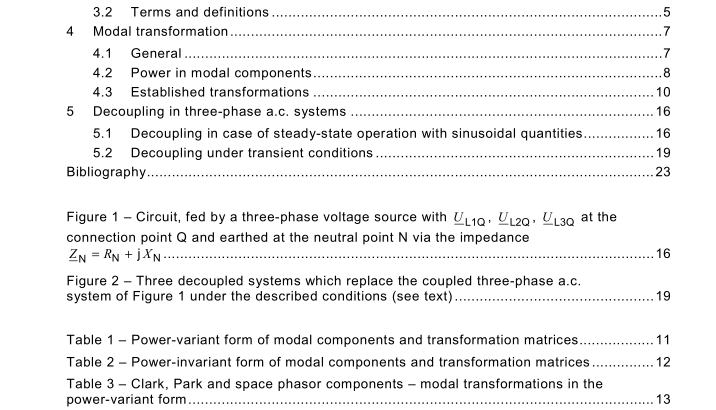IEC 62428:2008 pdf download – Electric power engineering – Modal components in three-phase a.c. systems – Quantities and transformations
IEC 62428 deals with transformations from original quantities into modalquantities for the widely used three-phase a.c. systems in the field of electric powerengineering.
The examination of operating conditions and transient phenomena in three-phase a.c.systems becomes more difficult by the resistive, inductive or capacitive coupling between thephase elements and line conductors. Calculation and description of these phenomena inthree-phase a.c. systems are easier if the quantities of the coupled phase elements and lineconductors are transformed into modal quantities.The calculation becomes very easy if thetransformation leads to decoupled modal systems. The original impedance and admittancematrices are transformed to modal impedance and admittance matrices. In the case ofdecoupling of the modal quantities,the modal impedance and admittance matrices becomediagonal matrices.
2Normative references
The following referenced documents are indispensable for the application of this document.For dated references, only the edition cited applies. For undated references, the latest editionof the referenced document (including any amendments) applies.
IEC 60050-141,International Electrotechnical Vocabulary (IEV) – Part 141: Polyphasesystems and circuits
3 Terms, definitions, quantities and concepts
3.1General
Quantities in this standard are usually time-dependent. These quantities are for instanceelectric currents,voltages, linked fluxes,current linkages, electric and magnetic fluxes.
For quantities the general letter symbol g in case of real instantaneous values, g in case ofcomplex instantaneous values and G in case of phasors (complex r.m.s. values) are used.
NOTE Complex quantities in this standard are underlined,Conjugated complex quantities are indicated by anadditional asterisk (*).Matrices and column vectors are printed in bold face type, italic.
3.2Terms and definitions
For the purposes of this document, the terms and definitions given in IEC 60050-141 and thefollowing apply.
3.2.1
original quantities
quantities g or G of a three-phase a.c. system
NOTESubscripts 1,2, 3 are generally used in this standard;additional letters may be put, for instance L1,L2,L3as established in lEC 60909.IEC 60865 and lEC 61660.
Power in modal components Transformation relations are used either in the power-variant form as given in Table 1 or in the power-invariant form as given in Table 2. For the power-invariant form of transformation, the power calculated with the three modal components is equal to the power calculated from the original quantities of a three-phase a.c. system with three line conductors and a neutral conductor, where 1 u , 2 u and 3 u are the line- to-neutral voltages and 1 i , 2 i and 3 i are the currents of the line conductors at a given location of the network. In a three-phase a.c. system with only three line conductors, 1 u , 2 u and 3 u are the voltages between the line conductors and a virtual star point at a given location of the network. The instantaneous power p expressed in terms of the original quantities is defined by:
NOTE The asterisks denote formally the complex conjugate of the currents 1 i , 2 i , 3 i . If these are real, ∗ 1 i , ∗ 2 i ,
